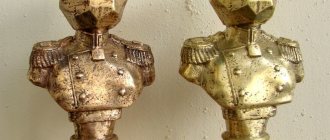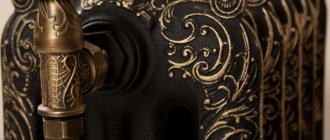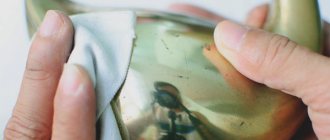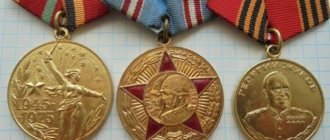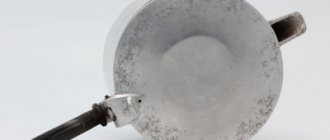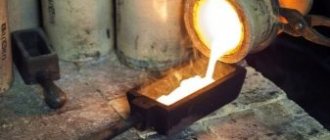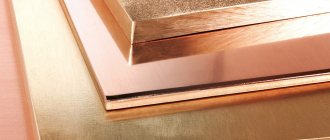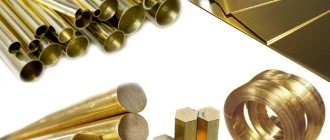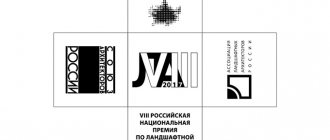Copper, brass and bronze are non-ferrous metals that are very similar in color and texture. It is very difficult to distinguish them without knowing their features.
On the Internet, images with these metals are most often labeled incorrectly, for example, under a photo with a copper bathtub it is written that it is bronze, or an image with a copper staircase is presented as brass.
How can you learn to understand them and never confuse them again?
As a designer, I feel these metals intuitively. In the photo, the metal is easiest to identify by color:
- if the item is pink or reddish in color, it is copper,
- if the yellow gold color is brass,
- if it has a greenish tint, it is bronze.
Copper
- This is a natural material, it is mined from iron ore, since there are almost no solid copper ingots left in nature.
Bronze
- is an alloy of copper and tin, and tin is the main component, it gives the alloy a greenish tint.
Brass
– an alloy of 70% copper and 30% zinc, i.e. copper is the main component.
Now I will tell you more about each metal:
What is bronze?
Before we figure out how to distinguish bronze from brass, let's find out what each alloy is. Let's start with bronze. So, bronze is an alloy of tin and copper, with admixtures of silicon, aluminum, beryllium and lead. It is the quality of the tin used that largely determines the nature of the future alloy.
There is a special type of bronze, in the manufacture of which tin is replaced with nickel or zinc. This alloy is known as spiatr. Essentially, the material is a cheap version of bronze, which is not of the best quality.
According to the above manufacturing principles, bronze is divided into tin and tin-free. At the beginning of the last century, metallurgists produced arsenic bronze. However, due to its high toxicity, the material was never widely used.
Etymology
Modern linguists put forward the following hypotheses about the origin of the word “bronze”:
- Romance, according to which the word came into the Romance languages either from the Persian “berenj”, meaning “copper”, or from the name of the city of Brindisi, from which this material was delivered to Rome;
- Proto-Slavic, according to which the word is of Proto-Slavic origin, and literally means “branched metal” (Common Slavic root “bron”, especially characteristic of South Slavic languages, and the suffix “za”, which in all likelihood denoted either the directly cast alloy or the technological process of its casting and cooling; as in the case of the common Slavic word for “iron” - “zelé(želě)-zo”), which is somehow preserved in almost all Slavic languages, and in the Slovenian language the word “bron” (without any postfixes) still means bronze;
What is brass?
Brass is practically the same alloy as bronze. But instead of the alloying composition in the form of tin, zinc is used here in combination with copper. Sometimes lead, iron, nickel, manganese, and other elements are added to the alloy.
The ancient Romans knew how to produce brass. They were the first to learn how to combine molten copper with zinc ore. Pure zinc began to be used for the production of brass only at the end of the 18th century in Britain. The British often used the alloy to create fake gold, because brass, like a noble metal, has an attractive sunny shine.
Today the material is widely used to create the so-called bimetal - an alloy where steel is combined with brass. This solution contributes to the production of metal that is resistant to corrosion and abrasion. At the same time, bimetal products have good ductility.
HTML Color Options
Antique Bronze, just like any other color, is a set of numerical parameters that can be displayed using a variety of color models. A color model is an abstract, mathematized system that allows any color to be represented as a set of numerical parameters.
RGB
RGB or Red, Green, Blue is a color model that describes colors as combinations of certain amounts of red, green and blue. This is an additive (from English to add - add) model, i.e. in it, varying amounts of red, green and blue are added to black, which symbolizes the absence of color. Antique bronze is composed of 40% red, 36% green and 12% blue. In absolute RGB units (where the minimum is 0 and the maximum is 255) this is 102 red, 91 green and 30 blue. Thus, Antique Bronze in the RGB system has the code rgb(102, 91, 30).
RGB graph
Antique bronze in the RGB system contains the following number of component colors: Antique bronze: amount of red Red Antique bronze: amount of green Green Antique bronze: amount of blue Blue
CMYK
CMYK or Cyan (cyan, also blue-green), Magenta (magenta or purple), Yellow (yellow), Key (key, also black) is a color model that describes any color as a combination of blue-green, purple and yellow. This is a subtractive model (from English to subtract - take away), within which different amounts of cyan, magenta, yellow and black are subtracted from white - the natural color of paper. Antique bronze is composed of 0% blue-green, 10% purple, 70% yellow and 60% black. In other words, Antique Bronze in the CMYK system has the code cmyk(0%, 10%, 70%, 60%)
CMYK chart
Antique Bronze in the CMYK system contains the following number of component colors: Antique Bronze: Cyan quantity Blue-green Antique Bronze: Magenta quantity Purple Antique Bronze: Yellow quantity Yellow Antique Bronze: Black quantity Black
The essence of materials
These metals are widely in demand today in the industrial sector. The color of brass and bronze of individual brands may be similar. However, they may differ in some of their properties. Bronze has been used by people for many thousands of years. Initially, bronze alloys were made, based on tin and copper. The metallurgical industry gradually developed, and people learned to exchange tin for other elements, such as iron, for example, or lead. Silicon, aluminum or beryllium and phosphorus could also serve as worthy alternatives. Depending on which basic materials were used, bronze can be:
- tin;
- tin-free.
The first type was used to cast bells; accordingly, it was called bell type. The chemical composition of the substance may change, but this directly affects both the color of the material and its characteristics.
The key alloying component of brass is zinc. This is a copper alloy containing manganese, iron, tin or lead. All these components may be present in minor concentrations. They are needed only to change the characteristics in one direction or another. The production of brass was known even to the inhabitants of Ancient Rome. They were able to create such a material by mixing zinc and pre-molten copper.
The most efficient production method was created in England. Scientists mixed pure zinc and molten copper. This technology was first discovered in 1781.
Brass is characterized by a golden tone. Due to its good decorative properties, it was used for a long time to produce jewelry, which was later passed off as gold. Gradually, manufacturers managed to pay attention to other, no less important parameters of brass. It turned out that it is different:
- corrosion resistance;
- plasticity;
- abrasion resistance;
- hardness;
- strength.
We recommend: Where to sell your old refrigerator for money
That is why today, as before, it is actively used in decorative products, but the range of its use does not end there. It has excellent casting properties. Accordingly, the material can be actively used in various industries.
What is more expensive, brass or bronze?
The cost of metals on the market is almost the same. In some collection points the price of bronze may be higher than brass alloys, in others it’s the opposite. If you want to know the cost, go to the "Sell Scrap Brass" section. Considering the average market value, we can note:
- Increased demand for brass. This metal is more often used for the manufacture of household products, plumbing equipment, pipes and other common goods.
- Components. Brass alloys are mainly made using zinc, bronze alloys - with tin and a number of other additives.
- Characteristics. With properties and physico-chemical data it is more difficult. Here the parameters depend on the percentage of copper content and additional components.
Considering these factors, the demand and composition of brass metals is more in demand, therefore the average price of this metal is 10–20 rubles per kg higher than that of bronze scrap.
Loft style in a bronze kitchen
Characterized by dark colors throughout, rough textures, brick walls, antique-style accessories, copper and bronze-colored lamps, uncovered pipes and wires. Its modern version is dominated by light gray tones of concrete floors, unplastered surfaces of brick walls, and an abundance of metal products.
The style is built on the contrast of a rough, simple finish, which serves as the background of the kitchen space, and the original design of furniture sets. Dark colors that predominate in the loft style require additional artificial lighting installed at different levels. Sunlight is usually not enough for loft-style rooms.
What is stronger, brass or bronze?
When comparing maximum permissible loads, wear resistance and other parameters, it is important to consider that the characteristics are affected by the composition of the alloys. For comparison, it is worth taking the highest grade metals. This will help you find out how brass differs from bronze in terms of physical and chemical parameters. Having studied the data, you can note:
- Bronze is heavier. The reason is the presence of tin. Its mass is greater than that of zinc.
- The corrosion resistance of brass is lower. Bronze can come into contact with salt water with little or no effect, but brass alloys must be alloyed to reduce the effects of corrosion.
- The wear resistance of bronze products is higher, since the metal has a lower coefficient of friction.
This is interesting: VGP pipe - decoding, description, advantages and scope of application
Based on these properties, it can be noted that bronze is stronger than brass when considering equally high-quality alloys.
Comparative characteristics and differences between metals
In the metallurgical industry, there are clear criteria for distinguishing between bronze and brass. However, if a person is not associated with this field of activity, he will not be able to determine by eye what material is in front of him. Combining copper with tin or zinc produces alloys that have different properties and are used in specific areas.
Bronze and brass have different properties and belong to completely different categories. The first alloy can be tin or tin-free, while the second can be two- or multi-component.
Bronze alloy consists of tin to which lead may be added. The color of the metal will depend on the percentage of one element or another. The main additive element in brass is zinc.
Bronze is resistant to chemical and aggressive compounds. In addition, its negative reaction to salty sea water made it possible to use the alloy in shipbuilding and navigation. Brass cannot boast of this, so to give it improved qualities, additional elements must be introduced into the alloy. In addition, bronze has better strength and anti-friction characteristics than brass. This allows you to significantly expand the scope of application of the alloy.
The high zinc content in brass gives the alloy a variety of colors from pink-red to golden yellow. This is what makes it similar to noble gold.
What does brass look like?
The silvery-white color of bronze is achieved by adding more than 35% Sn to its composition. An alloy containing at least 85% copper is brownish-red in color. Since compounds with high levels of impurities are rare, it can be argued that basically brass is a metal of golden yellow color, and bronze is closer to red, sometimes dark brown. The same colors of brass and bronze will appear on the broken objects. This allows you to easily distinguish brass products from bronze ones.
From a metal such as brass, not only decorative elements are made, such as furniture fittings or artistic objects for interior decoration, but also main parts used in various industrial fields.
Bronze and brass have a lower melting point than pure copper. This makes it possible to make various products from them for home use. Artistic casting made of bronze and brass looks very beautiful. However, for this you need to have the appropriate equipment and know the technology and rules for performing such a procedure.
Structure and color
To determine whether brass or bronze was used to make a product, you can look at the alloys and their fracture. Brass is lighter in color and fine-grained in cut. Bronze, on the other hand, has a coarse-grained structure and is distinguished by a dark brown tint.
Materials differ in a number of characteristics. These include the following features:
- The use of tin as an alloying element in bronze, and zinc in brass. The basic component of both metals is copper.
- Bronze, including those with a traditional chemical composition, copes well with aggressive components, including salty sea water.
- To impart maximum corrosion resistance, additional alloying elements are introduced into the brass composition.
Makeup mixes: metallic eye shades
Almost all shades of brown in the eyeshadow palette have echoes of bronze. This color allows you to create pearl of any gray or green. To create an interesting makeup, it is better to use dark colors:
- this will favorably emphasize the small shape of the eyes;
- light colors are suitable for retouching;
- medium intensity - ideal for daytime makeup.
The base shade should be a cool color - this is the basis for morning or business makeup. For evening makeup, choose dark brown undertones with a slight shimmer. You need to apply it to the outer corners of your eyes, then you can achieve a smoky smoky-eyes effect.
Comparison criteria
Despite the fact that in metallurgy there are clear criteria for distinguishing these two alloys, in real life an uninformed person is unlikely to accurately identify them.
Compound
Clear differences between metals can be traced only if the alloys do not contain impurities. However, now there are a large number of their varieties, which makes identification difficult. Brass is designated by the letter “L”; subsequent symbols in the marking indicate the presence of the main elements and the average copper content as a percentage. For example, L70 means 70% Cu content, and LAZ60-1-1 consists of 60% copper, 1% aluminum and 1% iron.
In a brass alloy, copper is combined with zinc, which gives the metal ductility and a low degree of wear resistance. This is the main additional element, but brass can be two-component or multi-component. There are different types of it.
- Deformable alloys. They are used in the production of machine parts, pipes, and springs.
- Foundries. Bearings, fittings, and devices designed to operate in conditions of elevated temperatures and aggressive environments are made from them.
- Jewelry brass. It is used to make jewelry, medals, decorative elements, and art products.
In bronze, copper is alloyed with tin, which makes the metal stronger, stronger and more durable. But sometimes aluminum, beryllium or magnesium are used instead. There are also several types of bronze.
- Tin bronze, also known as “bell” bronze. The main alloying element is tin. The alloy has good corrosion resistance and high anti-friction properties.
- Tin-free alloys. They use other components (aluminum, lead, beryllium, silicon and the like). These alloys are much softer and more ductile. The color of the material depends on the components it contains. For example, aluminum bronze has a distinctive golden-yellow color, which is why it has long been used as a substitute for gold in the production of coins and jewelry.
The most famous of the tin-free alloys is constantan. This heat-stable metal with high resistivity contains copper (about 59%) with the addition of nickel (39-41%) and manganese (1-2%).
By the way, the markings of bronze alloys do not indicate the percentage of copper, it is calculated. For example, BrA9Zh3L contains aluminum – 9% and iron – 3%. The letters “Br” mean bronze, and “L” means foundry.
Appearance
Due to its high zinc content, brass is similar in color to real gold. However, the shade directly depends on the percentage of a particular chemical element. Therefore, the spectrum of colors can vary from pink-red to golden yellow. Typically, brass appears as a yellow-golden metal.
This is interesting: Heat-resistant steel - grades, types and composition of heat-resistant steels and alloys
A bronze alloy has a silvery-white tone if it contains more than 35% tin. If its content reaches 40%, then the color of the metal is closer to white, reminiscent of steel. Products made from such bronze have a silver color with a light golden tint. If the composition contains a large proportion of copper (more than 85%), then the color of this metal is closer to red or dark brown.
Properties
Brass needs to improve its qualities, so various additional components are introduced into the alloy. Thanks to this alloying, the cast brass alloy is characterized by resistance to corrosion, low coefficient of friction, increased fluidity, low tendency to segregation, and excellent technological and mechanical properties.
Bronze has high strength properties and a low coefficient of friction. Due to its excellent resistance to the negative effects of aggressive environments, the metal is widely used in shipbuilding and shipping. Copper alloy has a wide range of applications - from decorative interior elements to critical parts.
Weight and strength
Brass is a more fragile and less durable material, prone to rapid wear. It is not used where high abrasion resistance is required. Due to the low density of zinc, brass is much lighter than bronze. Bronze is a wear-resistant and durable material. Due to its ductility, it is a favorite casting alloy for sculptors. It is much harder and stronger than brass. For example, a metal with 27% tin content is extremely hard, heavy and brittle. That is, the hardness of bronze depends on the percentage of tin in it. But this statement cannot apply to tin-free alloys.
More accurately, the specific gravity can be calculated by multiplying the density of the metal by the volume of the workpiece.
Usage
Bronze is used in modern mechanical engineering, rocketry, aviation, shipbuilding and other industries. Due to their resistance to mechanical abrasion and high corrosion resistance, bronze products are used for the manufacture of machine parts and devices involved in moving units in the friction process. Bronze parts require periodic replacement, that is, they are consumable. Tin-free bronze alloys are used to make rolled products for components of chemical devices, control valves for heating systems and pipelines for other purposes.
Bronze is used for casting sculptures and monuments, as the material is durable, not exposed to atmospheric influences and is resistant to mechanical damage. Products of highly artistic forms in theaters, palaces, and halls (chandeliers, floor lamps, candelabra) are also made of bronze.
Nuances of spectral comparative analysis
Due to the variety of copper-based alloys, it is difficult to accurately determine the type of their connection. Any of the methods to distinguish brass and bronze, even the most effective, does not provide a 100% guarantee. If you need an accurate answer to the question of what kind of alloy it is, then the only way to a reliable answer is to use spectral analysis. You can contact a scrap metal collection point, which may have the appropriate equipment.
Spectral analysis allows you to determine the chemical composition of a metal alloy based on its spectrum. In addition, this method has other advantages:
- high sensitivity;
- accuracy of results;
- studying the composition of brass and bronze products without destroying their structure;
- you can study the composition even on a small sample.
To carry out spectral analysis, a special tool is used - a steeloscope. It is designed for rapid visual qualitative and quantitative assessment of ferrous and non-ferrous alloys in the visible region of the spectrum.
Methods for chemical determination of alloys
Chemistry is a fairly effective way to identify brass and bronze. However, accurate results can only be obtained by reactions that destroy the metal, which will negatively affect the product. The chemical method includes the following steps:
- chips are removed from the copper alloy (so as not to damage the entire metal);
- mix a solution of nitric acid and water (in a ratio of 1:1);
- Next, you should place the chips in an acidic reagent;
- the solution is heated to boiling point after the chips are dissolved;
- The boiling temperature is maintained over low heat for half an hour.
If the shavings were brass, the solution in the container will remain transparent. When bronze dissolves, a tin precipitate (white) precipitates. Taking this into account, the method only works for bronze containing tin.
How to distinguish at home?
In practice, there are several simple and proven methods to help identify metals.
How to distinguish bronze from brass using a magnet?
- When it comes to a variety of alloys, it can be quite difficult to distinguish bronze from brass, because they can be almost identical. Many experts believe that bronze is heavier than brass. This is indeed due to the content of tin and lead, which are quite heavy.
- Brass is much lighter due to the presence of zinc. You can conduct a few simple experiments to find out which metal is in front of you. Bronze is almost always magnetic due to the presence of tin.
- That is, if you apply a strong enough magnet, you will see significant magnetization. The higher the tin content in the metal, the stronger the magnetization. Brass, in turn, does not exhibit magnetic properties, that is, when a magnet is placed, it does not stick at all.
Material processing
Determination by weight
This is another method of distinguishing metals. To identify the difference, it is enough to simply weigh bars of the same volume from different alloys in your hands. A bronze specimen will weigh much heavier than a brass blank.
However, the mass of the product is also affected by the density of the connections. Therefore, it is not always recommended to use weight as a clear criterion for distinguishing metals. For example, bronze with a low tin content (2-8%) is distinguished by the fact that it will weigh lighter than its brass counterpart.
How to test bronze by heating and filing at home
We provide you with two more verification options:
- Use a gas burner as it produces the highest temperatures (up to 600 degrees). A home stove will not be enough for this operation. In addition, the experiment will have to be carried out in a separate room (workshop or garage). Take the workpiece and hold it over the fire for a long time. Bronze will not change the appearance. And dark spots will appear on the surface of the brass product.
- If you have the possibility of completely melting the original sample, then conduct such an experiment. When overheated, a white flame and scattering flakes of the same color appeared. This means that Zn burns out and you have brass. It has good ductility. During deformation, it will not lose its physical properties, but bronze will certainly crumble and break if overheated.
- Sawing is the most affordable method that you can do at home without financial costs. Take a hacksaw and try to saw off samples. The brass product can be sawed well and easily, thereby forming layers. The shavings will have a twisted appearance. Metal containing tin when exposed to a sharp object will break into small pieces, producing fine dust. If you try to bend or flatten the sample, you will not achieve a positive result; you will only ruin the workpiece.
This is interesting: Copper resistivity. Formula for calculation
Drill Usage and Marking
Using a drill you can easily identify brass. But it is important to remember that the tool will damage the metal object. The fact is that during operation of the drill, chips come out from under the drill, which for copper are quite long and ornate, while for brass they are, on the contrary, short and needle-shaped. After all, the metal is much softer than its alloy.
Sometimes on a piece of the material being examined you can see markings that can easily tell you what is in front of a person. So, the mark on copper begins with the letter “M”, and on brass - with “L”. But in other countries, product labeling is somewhat different from Russian:
- In the USA you can see C2, C3, C4 badges on brass alloy.
- In the European Union, the letter C is placed on copper and brass, but after it on the metal you can see A, B, C, D, and on the alloy - L, M, N, P, R.
This method makes it quite easy to distinguish pure copper from brass. If markings are present, then you should not resort to other recognition methods.
Briefly about the properties of copper
Pure copper has high ductility and corrosion resistance, low specific gravity and high thermal conductivity. It lends itself well to pressure processing and is slightly less easy to cut. Pure copper is used for electrical wires. Its high thermal conductivity is used in various devices for heat removal, as well as in heat exchangers, including cooling radiators and heating systems. Copper pipes are used to transport gases and liquids and are also used in refrigeration units.
Differences in the nature of the fracture and evaluation of the finished product
Many people will even say, why bother figuring out whether it’s brass or copper if the two alloys look almost the same? But the fact is that this is important for many, in particular for people who will be involved in making some kind of sculptures or melting them down. Accordingly, very often a distinction is required if you are going to sell metal for scrap.
The fact is that brass is cheaper than bronze, so at a metal collection point they can simply deceive you and offer you a smaller amount. If the weight is small, then the losses will be insignificant, but if you have a fairly large amount of goods, then you will lose a decent amount of money. It is worth noting that there is no need to conduct tests, just look at the finished products. Brass is almost never used in shipping.
Locksmith tool
This material is destroyed when exposed to sea salt water, so compasses and some parts in shipbuilding are used exclusively in bronze. Therefore, if they are trying to deceive you, insist on checking the product, or contact a certified center. They usually have collection points as well as small compact laboratories. They can conduct a quick, simple analysis and analyze the product using laboratory equipment.
It is quite easy to distinguish between metals when viewing the fracture site. Brass breaks in fairly small grains, bronze breaks off in large pieces and has a coarse grain. At the same time, the color of the bronze fracture has a reddish tint; if it is brass, then it has a whitish or yellowish tint.
Accessories skull
Unfortunately, these methods cannot be used at home due to the lack of laboratory equipment. Magnet and chip tests are available for home users. They are also very informative.
Why was zinc added to copper and why are zinc statues not cast?
Copper is alloyed with zinc to create alloys with properties that copper and zinc do not have individually. Copper is a good conductor of heat and electricity. Copper is ductile, stretches, and can be stamped. Copper wires, copper tubes for refrigerators, heaters or air conditioners, copper utensils fully realize the properties of copper, such as heat and electrical conductivity, and high ductility. Corrosion resistance and chemical inertness to household solutions make it possible to produce copper cookware, frying pans, and pots. But the downside of the properties of copper is that it has insufficient strength, hardness, corrosion resistance and high cost for widespread use in technology as a structural material. For five thousand years, people have been modifying copper by adding other metals to the melt to measure its properties.
Receipt
Bronze is produced by fusing copper and alloying components. The process takes place in electric induction furnaces or crucible furnaces. The smelting charge can consist of fresh metals, as well as production waste and secondary metals. Melting is carried out under a layer of flux or charcoal.
The required amount of coal or flux is placed in a heated furnace, and then copper is loaded. After melting and heating the copper to the appropriate temperature, the melt is deoxidized with copper phosphate. Next, heated alloying elements are introduced into the melt. Refractory alloying elements are introduced in the form of alloys. The melt is stirred until the components dissolve and heated to the required temperature. Before casting, the melt is again deoxidized with phosphorous copper to eliminate its oxides.
Bronze melts well and fills ingot molds evenly. The alloys are produced in the form of flat and round ingots. Ingots are processed by rolling or pressing.
The result is a wide range of rolled metal:
- bronze ribbon;
- bronze wire;
- bronze pipe;
- bronze bushings;
- bronze circle;
- bronze rod.
Application area
Bronze is more durable. Based on it, you can create decorative elements of increased strength that can last for a long time. It is used for various industrial sectors when it is necessary to produce reliable parts. Brass is more often used in the manufacture of metal elements with high corrosion resistance.
Compared to copper, bronze and brass have a lower melting point. This property can be used to make various products with your own hands. True, you will have to stock up on the appropriate tools and equipment. It is also important to adhere to the rules of technological operations and study casting technology.
Sources
- https://titan-spec.ru/harakteristiki/sostav-bronzy-i-latuni-otlichie.html
- https://sdaymetall.ru/stati/kak-otlichit-bronzu-ot-latuni/
- https://1nerudnyi.ru/latun-i-bronza-01/
- https://intehstroy-spb.ru/spravochnik/kak-otlichit-latun-i-bronzu-v-domashnih-usloviyah.html
- https://vplate.ru/metally-i-splavy/bronzu-ot-latuni/
- https://metallolom-msk.ru/kak-otlichit-latun-ot-bronzy.html
- https://molotok34.ru/spravochnik/kak-otlichit-bronzu-ot-latuni.html
- https://www.rocta.ru/info/kak-otlichit-bronzu-ot-latuni-proverka-v-domashnikh-usloviyakh/
- https://msmetall.ru/metally/bronza-i-latun-raznica.html
